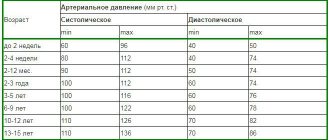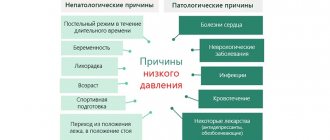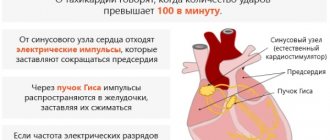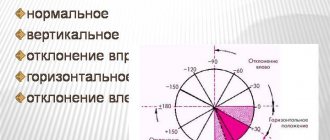Palpitation is a condition in which heartbeats are felt. In the normal rhythm of life they are very difficult to track. Therefore, when such phenomena occur, a person may have concerns about his own health.
To understand in what cases it is necessary to seek help, it is important to be able to distinguish tachycardia from normal palpitations, which may occur due to a combination of certain circumstances.
Tachycardia is an increased heart rate, which reaches 90-100 beats per minute. This disease can be determined by counting a woman's pulse. Palpitations are most often just complaints that do not always depend on the pulse rate.
To find out what the cause is, you need to count your pulse rate and pay attention to the presence of other symptoms. If the pulse rate is between 60-90 beats per minute, the blood pressure is normal and there are no other signs of deterioration in health, this situation does not require special help. If the pulse rate is within normal limits, but there are surges in blood pressure, signs of dizziness, or a state of fainting, then there is a need to seek help from specialists.
Pulse and blood pressure indicators are the main components of normal physical condition. Pressure is the force with which the blood presses on the vessels. Pulse describes the beats of the heart per minute. In adult women, fluctuations in the range of 60-100 beats are considered indicators of a normal heartbeat. Blood pressure is considered normal within 120-80.
The easiest way to determine your heart rate
Measuring the amount of vibration of arterial walls
In order to take measurements and find out the normal pulse
it is necessary to use the palpation method in the following places:
- Armpits.
- Elbow bend.
- Wrists.
- Inner thigh.
- Carotid artery.
- Viska.
Do not measure your heart rate immediately after eating or exercising.
In the morning, when the body is at rest, you need to apply two fingers (index and middle) to the neck, thigh and temple alternately. The beats are counted for 60 seconds. You can use a stopwatch or time yourself.
You can measure the oscillation frequency using a tonometer: this device is intended not only for measuring blood pressure.
how many beats per minute
Changing the number of strokes is possible in the following cases:
- Physical stress on the body.
- Stressful situation, excitement.
- Taking medications.
- Consumption of alcoholic beverages and tobacco products.
- Change in body temperature.
If the number of vibrations becomes less than 50 beats per minute, this indicates the presence of any pathologies. As a rule, a person experiences weakness and nausea. If the number of oscillations is reduced to 35 beats, the brain begins to experience oxygen starvation. Read here and find out why your blood pressure rises.
Increased heart rate during sleep
Reducing the impulses of the cardiovascular system during rest is considered natural for a healthy person. Medical experts confirm the dependence of heart rate rhythms on the effectiveness of sleep, its depth and quality.
In most cases, sleeping people see dreams in color or black and white. Beautiful and pleasant dreams periodically change to nightmares, which affect the nervous system. The result may even be a jump in blood pressure. But this is not the only thing that affects the quality of dreams.
Tachycardia in the morning
Heart rate fluctuations during sleep can also cause:
- changes in the functioning of the thyroid gland;
- prolonged stress and depression;
- impaired blood circulation;
- slagging of the body and intoxication;
- internal bleeding;
- lack of water in the body.
Tachycardia harms proper sleep, causing anxiety with possible headaches and pressing pain in the chest.
The number of beats in the male body at rest
If you compare the number of vibrations of the arterial walls per minute in a man and a woman, the values will differ by 10 beats.
First of all, this depends on the different structure of organisms: per kilogram of body weight for a man there is 65 ml of blood, while for a woman this figure is 60 ml. This is explained by the fact that the volume of the male heart is slightly larger than the female organ.
A man's maximum oxygen consumption is also higher, and this has a direct impact on the number of contractions.
What is the normal heart rate per minute for a person
? The resting heart rate of a man in good physical condition reaches 50 beats per minute. Rarely the value may be reduced. This is normal for an athlete's heart.
Treatment methods
Therapeutic measures are divided into several groups:
- Use of medications.
- Folk recipes.
- Surgical intervention.
- Lifestyle changes.
Medicines. The following groups of pharmaceuticals are used as a primary method:
- Beta blockers. To reduce the sensitivity of special receptors in the body. Carvedilol or Anaprilin, Metoprolol.
- Sedative drugs. Herbal (motherwort, valerian in tablet form). Accelerate inhibition of the nervous system.
- Tranquilizers. They influence in the same way. Diazepam, Sibazon, Relanium are used.
- Calcium channel blockers. Prevents the penetration of element ions into blood vessels and tissues. Thus, the blood supply structures are not narrowed, and the third reflex zone of the heart is not stimulated. Diltiazem and Verapamil are suitable.
Cardiac glycosides are used a little less frequently: Digoxin and tincture of lily of the valley.
Traditional methods:
- Honey and lemon (2 tablespoons of the mixture 3 times a day). St. John's wort, motherwort, valerian, anise, peppermint in tea form. Take 2 glasses
- once a day
- Chokeberry tincture (200 berries per 400 ml of vodka, prepared in 21 days). Take 2 teaspoons 2 times a day.
Before use, it is better to consult with a naturopath or, at a minimum, a cardiologist.
Surgery. Indicated in extreme cases: in case of heart defects, it is aimed at creating an anatomical defect, in case of a tumor process, excision of neoplasm, in case of stable tachycardia, installation of an artificial pacemaker (pacemaker), and in case of destruction of the atria as a result of infectious pathologies, through prosthetics.
Lifestyle changes.
- Quitting smoking and alcohol.
- Normalization of sleep. 8 hours per night, most of the rest should occur before 23.00.
- Drinking regime. 2 liters per day.
- Salt. No more than 7 grams.
- Physical activity. 2 hours, light walks or exercise therapy.
- Breathing exercises (not according to Strelnikova). The program is selected individually.
Diet correction.
Can:
- Vegetables and fruits without restrictions.
- Juices.
- Cereal porridge with water and milk.
- Lean meat, soups.
- Coarse bread.
- Berries, natural sweets.
- Eggs.
- Butter, vegetable oils.
It is forbidden:
- Fat meat.
- I'll bake it.
- Fried pies.
- Smoked meats.
- Salt more than 7 grams.
- Coffee and tea.
- Canned food, semi-finished products.
Treatment tables No. 3 and No. 10 are shown. The menu is compiled independently or on the advice of a nutritionist. Cooking methods: boiling, steaming, baking. Compliance with the principle of fractional meals (3-5 times a day); you cannot eat at night.
Number of beats in the female body at rest
How long does a person have a normal pulse?
? The female body is structured differently: at rest, the number of vibrations of female arteries varies from 60 to 70 beats per minute.
A woman’s pulse is influenced by hormonal levels, which change at the beginning of the menstrual cycle. In the first phase, at rest, a woman’s pulse is 10 beats per minute. This value is typical for the third phase of the cycle.
Menopause is a physiological phenomenon that is also reflected in the number of oscillations of the arteries: at rest, the number of beats reaches 80 - this is the normal number of beats per minute of the heart
. During pregnancy, the heart rate also changes: an increase in beats is observed (+10 to the average value at rest).
How to measure a sleeping person's pulse
There are several ways to check the pulse rate of a sleeping person. The first is the traditional pressing of the fingers on the wrist and counting the number of blows. You can ask a close relative who will measure your pulse in different phases of sleep.
Another way is a modern heart rate monitor device with a built-in alarm clock. Its functions are to count the rhythmic beats of the arteries. During sleep, the device reads various indicators related to the body:
- reflects the position;
- draws up schedules;
- records sleep phases and number of beats.
A heart rate monitor is a device that allows you to measure your heart rate during sleep.
Then it analyzes all the collected data and determines a favorable time to wake up, which gives a signal to the built-in alarm clock to vibrate. The “heart rate monitor” is a great way to determine the quality of sleep and check the functioning of the cardiovascular system at rest. These are also analytical system indicators that reflect the health of a sleeping person.
Possible reasons for deviations of the pulse value from the established norm
The most common reasons affecting the change in the number of strokes are:
- Physical stress on the body.
- Regular exercise.
- Sexual intercourse.
- Feeling very hungry.
- Oversaturation of the body.
- Stressful situation.
- Drinking alcoholic beverages.
- Drug use.
- Use of tobacco products.
- The beginning of a woman's menstruation.
- A course of massage or other procedures that relax the body.
reasons for abnormal heart rate
ECG indicators
The main indicators of the electrocardiogram characterizing the work of the myocardium are waves, segments and intervals.
Serrations are all sharp and rounded bumps written along the vertical Y axis, which can be positive (upward), negative (downward), or biphasic. There are five main waves that are necessarily present on the ECG graph:
- P – recorded after the occurrence of an impulse in the sinus node and sequential contraction of the right and left atria;
- Q – recorded when an impulse appears from the interventricular septum;
- R, S – characterize ventricular contractions;
- T - indicates the process of relaxation of the ventricles.
Segments are areas with straight lines, indicating the time of tension or relaxation of the ventricles. There are two main segments in the electrocardiogram:
- PQ – duration of ventricular excitation;
- ST – relaxation time.
An interval is a section of an electrocardiogram consisting of a wave and a segment. When studying the PQ, ST, QT intervals, the time of propagation of excitation in each atrium, in the left and right ventricles is taken into account.
Slow and fast heartbeat
The heart muscle can contract at an increased (tachycardia) or decreased (bradycardia) rhythm. If the pulse does not correspond to the norm, there is no need to immediately sound the alarm: the reason may be not only in pathology, but also in the physiology of the female or male body. Thus, some increase in heart rate is observed when women reach menopause, or when estrogen levels decrease; slowing of the pulse - when taking certain medications.
Various physical and mental stress affect the heart rate, even the difficult digestion process after a heavy holiday dinner and the use of energy drinks. Typically, physiological causes of abnormal heart rate are temporary. After 45 minutes, the pulse readings can return to normal.
Record your heart rate readings on both hands - this will allow you to get more accurate data when measuring this indicator manually.
Clinical practice shows that the pulse often increases when the nervous system is damaged, cardiac pathology, or hormonal system disorders. It is possible that with high readings a tumor or some kind of infection develops in the body.
The pulse slows down if the body experiences intoxication, peptic ulcer disease, or increased intracranial pressure, myocardial infarction develops. Perhaps this signals a lack of thyroid hormones, organic damage to the heart, or poor oxygen supply to tissues.
Only a specialist can answer the question why your pulse is too fast or too rare. In any case, consult a doctor immediately if your pulse is abnormal:
- dyspnea
- my head is spinning
- fainting or presyncope
- heart pain
- vision problems
When playing sports, it is important to regularly measure your pulse.










